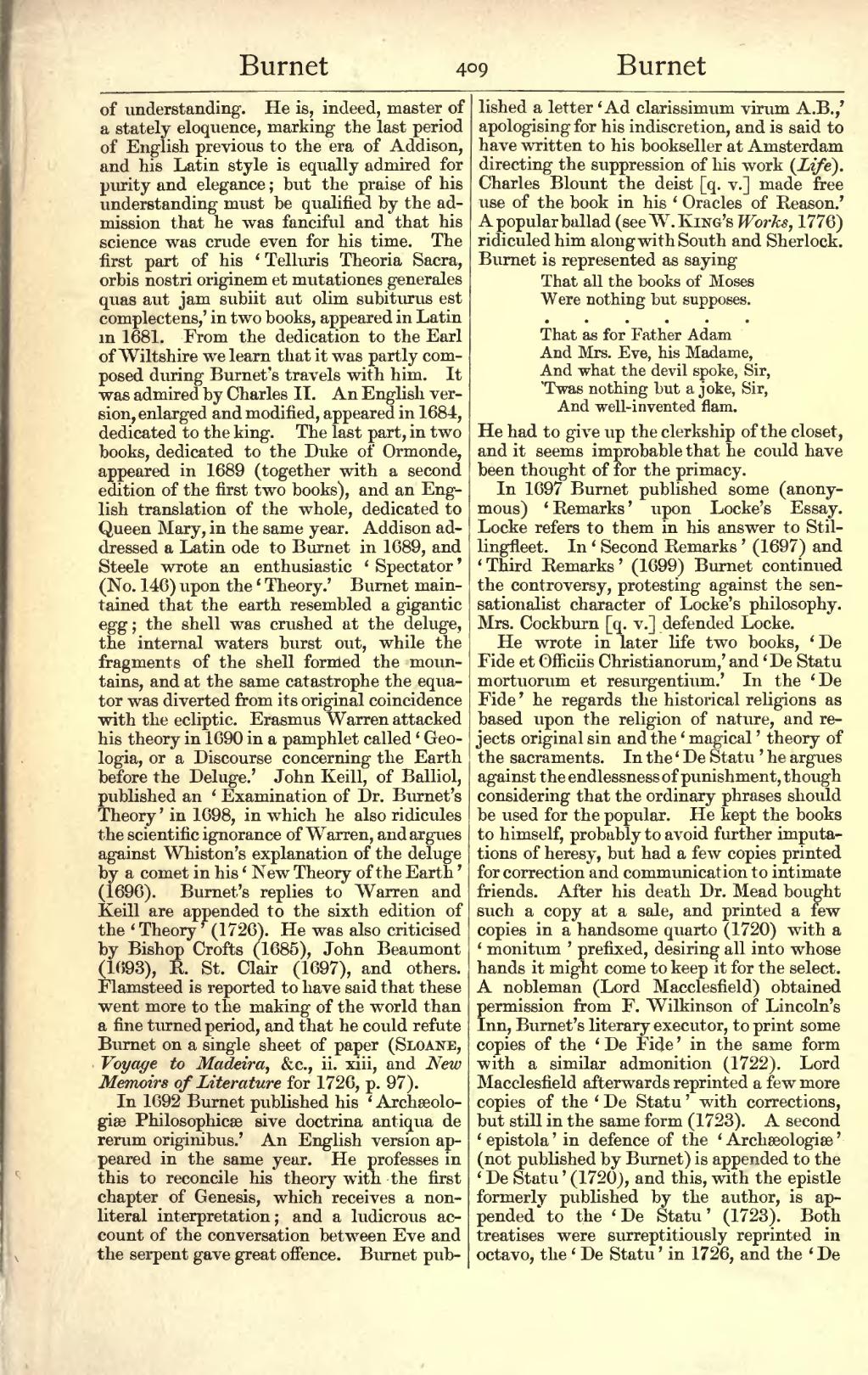of understanding. He is, indeed, master of a stately eloquence, marking the last period of English previous to the era of Addison, and his Latin style is equally admired for purity and elegance; but the praise of his understanding must be qualified by the admission that he was fanciful and that his science was crude even for his time. The first part of his ‘Telluris Theoria Sacra, orbis nostri originem et mutationes generales quas aut jam subiit aut olim subiturus est complectens,’ in two books, appeared in Latin in 1681. From the dedication to the Earl of Wiltshire we learn that it was partly composed during Burnet's travels with him. It was admired by Charles II. An English version, enlarged and modified, appeared in 1684, dedicated to the king. The last part, in two books, dedicated to the Duke of Ormonde, appeared in 1689 (together with a second edition of the first two books), and an English translation of the whole, dedicated to Queen Mary, in the same year. Addison addressed a Latin ode to Burnet in 1689, and Steele wrote an enthusiastic ‘Spectator’ (No. 146) upon the ‘Theory.’ Burnet maintained that the earth resembled a gigantic egg; the shell was crushed at the deluge, the internal waters burst out, while the fragments of the shell formed the mountains, and at the same catastrophe the equator was diverted from its original coincidence with the ecliptic. Erasmus Warren attacked his theory in 1690 in a pamphlet called ‘Geologia, or a Discourse concerning the Earth before the Deluge.’ John Keill, of Balliol, published an ‘Examination of Dr. Burnet's Theory’ in 1698, in which he also ridicules the scientific ignorance of Warren, and argues against Whiston's explanation of the deluge by a comet in his ‘New Theory of the Earth’ (1696). Burnet's replies to Warren and Keill are appended to the sixth edition of the ‘Theory’ (1726). He was also criticised by Bishop Crofts (1685), John Beaumont (1693), R. St. Clair (1697), and others. Flamsteed is reported to have said that these went more to the making of the world than a fine turned period, and that he could refute Burnet on a single sheet of paper (Sloane, Voyage to Madeira, &c., ii. xiii, and New Memoirs of Literature for 1726, p. 97).
In 1692 Burnet published his ‘Archæologiæ Philosophicæ sive doctrina antiqua de rerum originibus.’ An English version appeared in the same year. He professes in this to reconcile his theory with the first chapter of Genesis, which receives a non-literal interpretation; and a ludicrous account of the conversation between Eve and the serpent gave great offence. Burnet published a letter ‘Ad clarissimum virum A.B.,’ apologising for his indiscretion, and is said to have written to his bookseller at Amsterdam directing the suppression of his work (Life). Charles Blount the deist [q. v.] made free use of the book in his ‘Oracles of Reason.’ A popular ballad (see W. King's Works, 1776) ridiculed him along with South and Sherlock. Burnet is represented as saying
That all the books of Moses
Were nothing but supposes.
......
That as for Father Adam
And Mrs. Eve, his Madame,
And what the devil spoke, Sir,
'Twas nothing but a joke, Sir,
And well-invented flam.
He had to give up the clerkship of the closet, and it seems improbable that he could have been thought of for the primacy.
In 1697 Burnet published some (anonymous) ‘Remarks’ upon Locke's Essay. Locke refers to them in his answer to Stillingfleet. In ‘Second Remarks’ (1697) and ‘Third Remarks’ (1699) Burnet continued the controversy, protesting against the sensationalist character of Locke's philosophy. Mrs. Cockburn [q. v.] defended Locke.
He wrote in later life two books, ‘De Fide et Officiis Christianorum,’ and ‘De Statu mortuorum et resurgentium.’ In the ‘De Fide’ he regards the historical religions as based upon the religion of nature, and rejects original sin and the ‘magical’ theory of the sacraments. In the ‘De Statu’ he argues against the endlessness of punishment, though considering that the ordinary phrases should be used for the popular. He kept the books to himself, probably to avoid further imputations of heresy, but had a few copies printed for correction and communication to intimate friends. After his death Dr. Mead bought such a copy at a sale, and printed a few copies in a handsome quarto (1720) with a ‘monitum’ prefixed, desiring all into whose hands it might come to keep it for the select. A nobleman (Lord Macclesfield) obtained permission from F. Wilkinson of Lincoln's Inn, Burnet's literary executor, to print some copies of the ‘De Fide’ in the same form with a similar admonition (1722). Lord Macclesfield afterwards reprinted a few more copies of the ‘De Statu’ with corrections, but still in the same form (1723). A second ‘epistola’ in defence of the ‘Archæologiæ’ (not published by Burnet) is appended to the ‘De Statu’ (1720), and this, with the epistle formerly published by the author, is appended to the ‘De Statu’ (1723). Both treatises were surreptitiously reprinted in octavo, the ‘De Statu’ in 1726, and the ‘De
